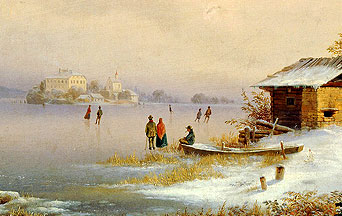
The Little Ice Age: How Climate Made History 1300-1850 tells a fascinating story with a questionable conclusion. It is challenging to place its author, Professor Brian Fagan, in any single academic discipline. He was a professor of anthropology at the University of California, Santa Barbara, from 1967 to 2003. His biography also mentions archaeology, museum work, and authorship of several books on historical climate change. He first wrote Little Ice Age in 2000 and updated it in 2019.
It Has Happened Before
Global climate change is nothing new. Throughout human history, there have been long cycles of relative warmth and cold. Determining precise dates is impossible. The “Medieval Warm Period,” which Prof. Fagan discussed in his book The Great Warming, started about 800 A.D. and lasted five centuries. It then developed into The Little Ice Age. Complicating the issue are short periods of warmth within centuries of cold.
10 Razones Por las Cuales el “Matrimonio” Homosexual es Dañino y tiene que Ser Desaprobado
The book tells two stories. The more scientific story discusses prevailing wind patterns that spread heat or cold. A prime example is the “North Atlantic Oscillation,” which figures prominently in his narrative.
Prof. Fagan describes this phenomenon as, “a seesaw of atmospheric pressure between a persistent high over the Azores and an equally prevalent low over Iceland…. [T]he NAO governs the position and strength of the North Atlantic storm track and thus the rain that falls on Europe, especially during winter.” He further explains that a high NAO brings warm winds from the west into the heart of Europe. A low NAO produces colder temperatures. “The swings are unpredictable and sudden.”
God’s Gift of Resourcefulness
The second story is the more engaging epic story of how humanity reacted to the changes. Unusual cold could cause great tragedy as when early frosts and crop failures in Poland and the Russian plains in 1215 resulted in survival measures to deal with famine. Warmth presented a far greater opportunity. A series of warm summers between 1284 and 1311 encouraged many English farmers to plant vineyards.
Eternal and Natural Law: The Foundation of Morals and Law
Occasionally these “stories within the story” are simply marvelous. One such example of supernatural resourcefulness involves the French Alpine region called Chamonix. In 1644, its situation was bleak. An approaching glacier threatened several villages. A delegation begged for the Bishop of Geneva’s intervention.
“In early June 1644, the bishop himself led a procession of about three hundred people to the place where the ‘great and terrible’ glacier threatened the village of Les Bois. The prelate blessed the menacing ice sheet, then repeated the ritual at another glacier near the village of Largentière, at one poised near Le Tour, and at a fourth ice sheet at Les Bosson. The villages were literally hemmed in by moving ice…. Fortunately, the blessings worked. The glaciers slowly retreated until 1663, but they left the land so scarred and barren that nothing would grow.”
A broader part of the historic narrative describes the effect of the increasing cold on Great Britain. During the last third of the eighteenth century, agricultural production had fallen off so much that large scale starvation loomed. In response, British agriculture shifted to root vegetables—potatoes, turnips, carrots—and away from grains. There was also a shift to livestock production, the cows and pigs eating the turnips. New farming tools improved yields. The result is sometimes called the “agricultural revolution.”
Learn All About the Prophecies of Our Lady of Good Success About Our Times
Descent into Alarmism
In chronicling the effect of climate change on human history, this book does a great job with a largely-unexamined set of facts. If the book ended on page 197, this would be a thoroughly positive review. Unfortunately, the author descends into the age of man-made global warming alarmism that seems to contradict his earlier conclusion of climate change as something normal.
“If warming continues on its present trajectory, growing seasons in Europe will lengthen, vineyards will again be established in central England, and farms will be cleared closer to the Arctic Circle. Northern Europe and much of North America may prosper from the warmth, but southern Europe, much of tropical Africa, and Central and South America will suffer more frequent water shortages and greater heat, as well as diminished agricultural capacity.”
The book takes on an apocalyptic tone by presupposing drastic social and political scenarios. “[I]t’s implausible to suppose that famines and massive dislocations of poor populations will be unaccompanied by civil unrest and disobedience…. We would be rash to ignore even theoretical scenarios, for we and our descendants are navigating uncharted climatic waters.”
Navigating Uncharted Waters
This surprising conclusion follows a narrative that shows humanity has always been “navigating uncharted climatic waters.” Humanity has survived these stormy seas by using the God-given powers of reason, resourcefulness and deduction. There is no reason to believe that such survival will not happen again.
Science Confirms: Angels Took the House of Our Lady of Nazareth to Loreto
Professor Fagan paints an engaging portrait of humanity, adapting to climate changes beyond their control. If he could see the obvious conclusion of his work, its value would grow. Yes, the climate will warm up but also cool down. Understanding the successful and disastrous reactions of previous generations could serve as a guide for future action. Pretending that humanity has the power to warm or cool the Earth leads down the wrong path. Confiding in God and His Providence is a far safer road.

